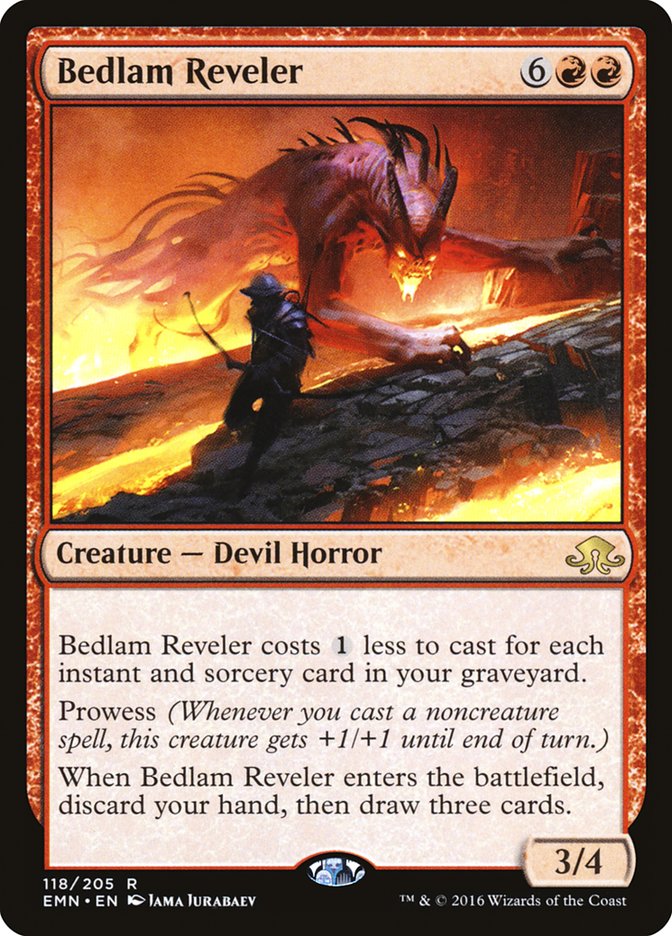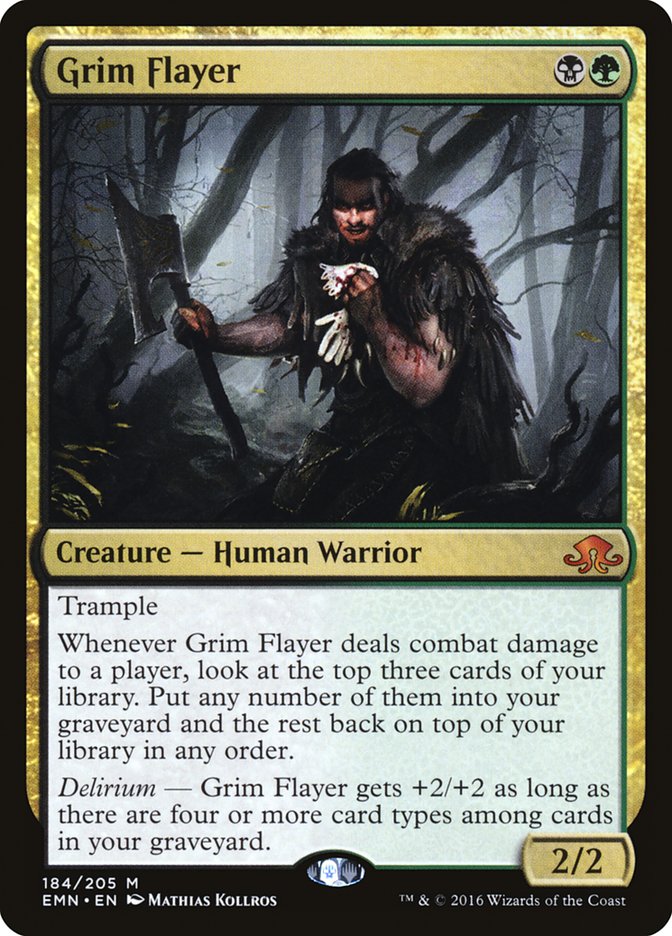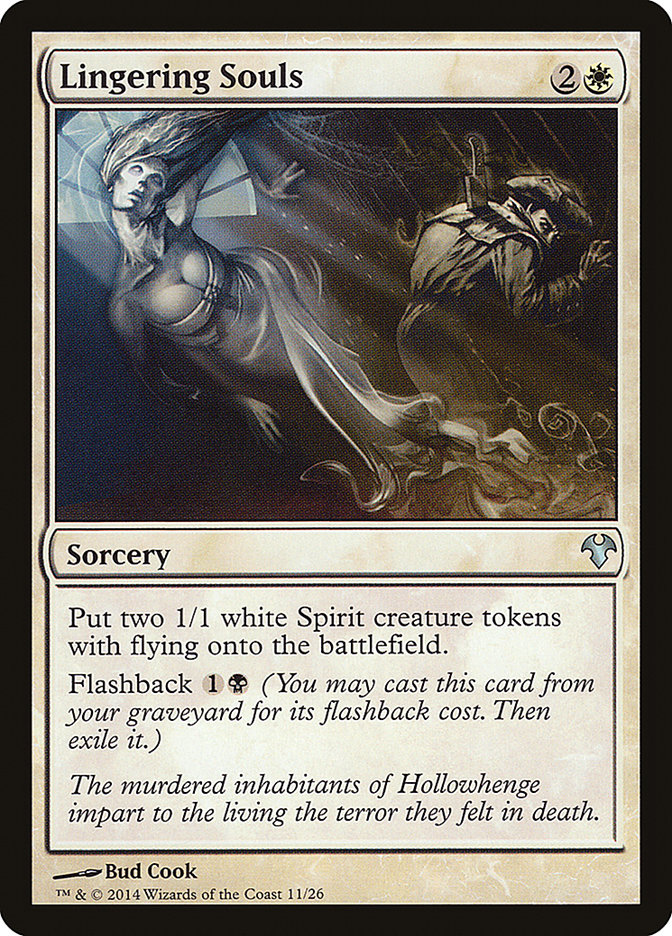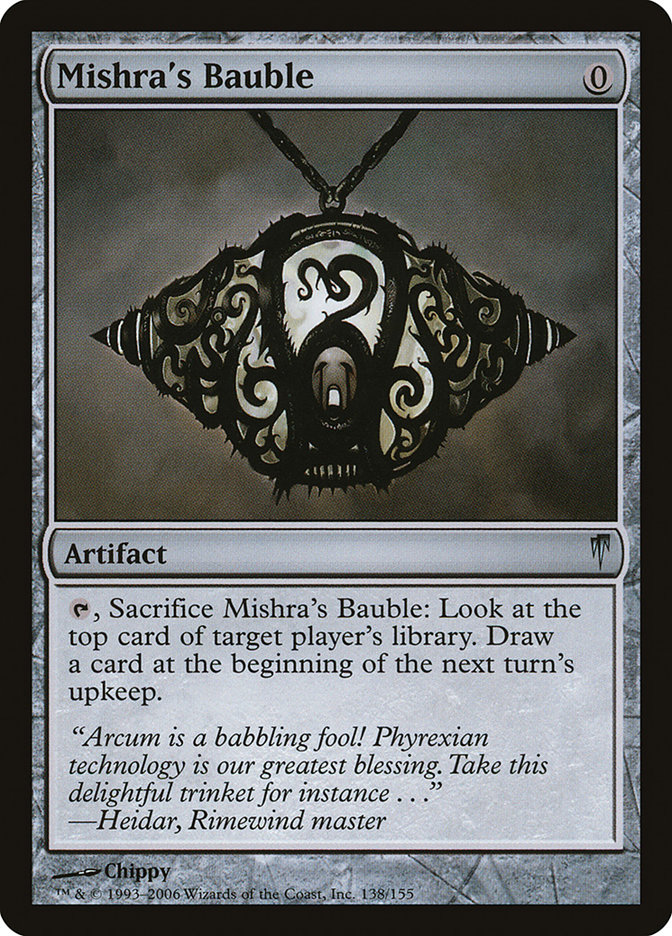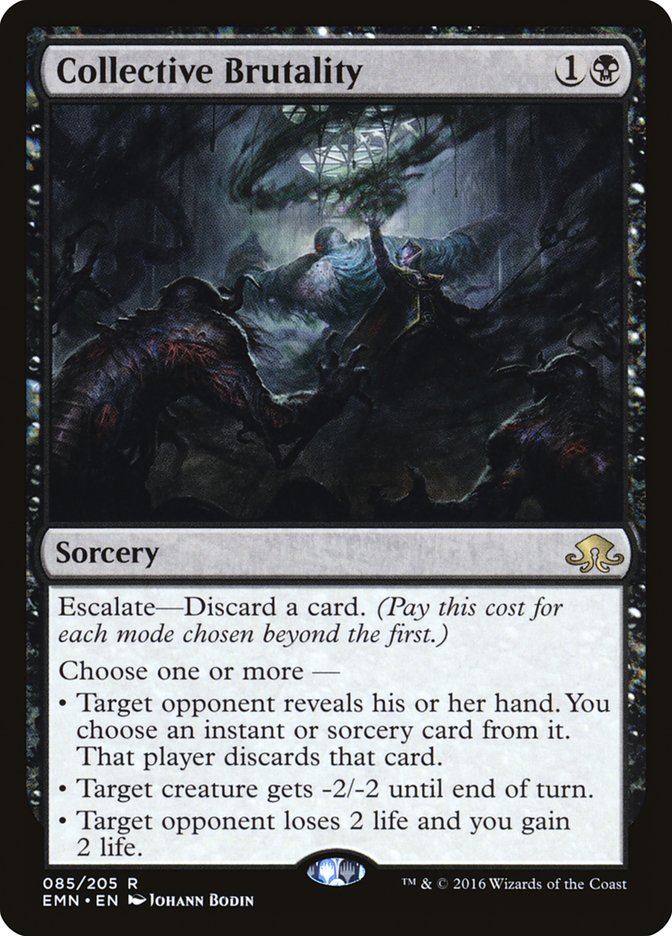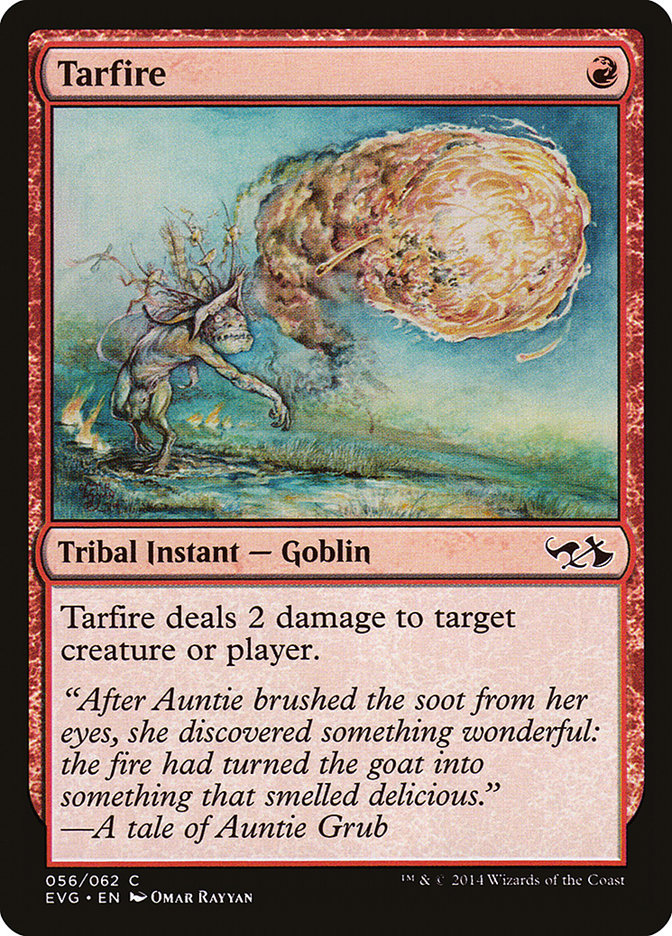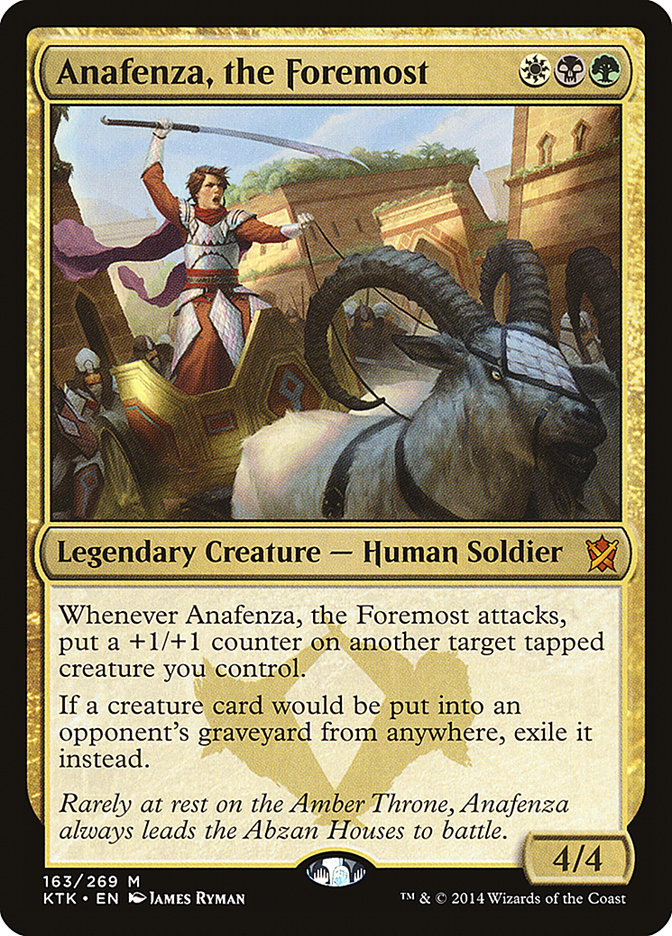In preparation for the MOCS quarterly championship last Saturday and the #SCGINVI in New Jersey this weekend, I’ve been playing a lot of Modern on Magic Online. Eldritch Moon brought a significant number of impactful cards to the Modern format that haven’t had much of a chance to be put in the spotlight until this past weekend.
I personally started with a bunch of Grixis Control brews (shocking I know) but ultimately couldn’t get the numbers or some of the more obscure things I looked at to work in time for this past weekend.
I’ll get to some of the other brews later in the article, but for now I want to focus on Jund.
It might be odd that I would be interested in Jund, but to make a long story short, it appears as if most of the control decks are becoming increasingly poorly positioned in Modern. Dredge is on the rise and is further validated by Ross Merriam’s win two days ago. The deck is disgusting and it was already difficult for Grixis Control to navigate several unfair and big-mana matchups. Against Dredge it’s virtually impossible to play a proper reactive game; your only real hope is to hate them out directly from the sideboard when you’re trying to play Serum Visions and countermagic.
When Dredge, Burn, Death’s Shadow Zoo, Bant Eldrazi, and Affinity make up a significant portion of the online metagame and real-life events have been on relative hiatus the last few months, the advice I’d been getting was that Jund would probably be a good place to look toward. Simultaneously, I spotted this beauty that sparked my interest through proxy of Ross.
Creatures (13)
- 4 Tarmogoyf
- 1 Scavenging Ooze
- 1 Courser of Kruphix
- 1 Kalitas, Traitor of Ghet
- 4 Grim Flayer
- 2 Bedlam Reveler
Lands (21)
Spells (26)

I have some underlying issues with Austin’s approach. As cool as the deck is, it is remarkably difficult to try to build decks that need to jump through hoops to achieve their synergy. In particular, when you might need to make a specific sequence to turn on your Traverse the Ulvenwald to finally find your bullet, the window in which that bullet is impactful might be lost. Traverse is certainly going to be an excellent card to topdeck in the late game, but trying to make it work in this regard feels a bit forced to me.
I love the idea of Bedlam Reveler (and have a few lists coming later featuring it), but some bizarre flowchart of needing delirium that supports creatures that need spells is a bit too demanding for my tastes.
I don’t mean to be overtly negative towards Mr. Hoth’s deck, but rather to illustrate the effects of going down the rabbit hole – I’ve been there, of course. Simply, as sweet as trying to support these new cards can be, it’s best to not deviate from a more focused and linear strategy exactly because of the presence of massively punishing decks like the aforementioned Burn and Dredge.
However, there is a truth to be gleaned from all this: Grim Flayer is great. I’m not sure whether Grim Flayer was put into his deck originally to simply support the Traverse-bullet engine, but the Flayer is certainly a Modern-playable card that people aren’t talking about yet. Sorta. (Spoiler: Jacob Wilson won the MOCS with it.)
Before I specifically start to talk about Grim Flayer, here’s what I played in the MOCS:
Creatures (13)
Planeswalkers (4)
Lands (23)
Spells (20)

Why Play Grim Flayer?
The best short-and-sweet comparison I can draw to Grim Flayer is being a watered-down Dragonlord Ojutai. Grim Flayer is a two-drop that essentially forces your opponent to play defensively, kill it, or be capable of completely ignoring what you’re doing. If Grim Flayer triggers, then it is nearly guaranteed to find additionally means to get it through again, feeding you more removal or more threats. This is completely ignoring any additional graveyard synergy you can generate, like growing your Tarmogoyfs or depositing Lingering Souls (how in the world did I miss this?).
While it doesn’t draw physical cards, it certainly generates card advantage through selection and helps you make informed decisions for sequencing optimally. It’s also quite difficult to contain once it becomes a 4/4; it can’t be killed by Lightning Bolt or effectively chump blocked, making it an impactful draw later in the game as well.
You’ll notice that I made some half measures to support it, cutting a land but playing four Mishra’s Bauble, which I also do generally like as a means to help filter your draws with fetchlands or get more information from an opponent. That said, I consistently ran into difficultly achieving delirium if I was ever incentivized to sideboard out my Lightning Bolts. The deck actually has very few instants and you’re unlikely to want to bin a creature with Grim Flayer’s ability in Jund due to being so threat-light, often creating the situation where you are connecting but still only have a 2/2 with sorcery/land/X in the graveyard.
I didn’t perform well, but my deck also wasn’t particularly built correctly either. That said, I do want to highlight my inclusion of Collective Brutality specifically. Brutality started to see a little press from the coverage booth this weekend as a sideboard card for Ross Merriam (and winning him at least one game directly on camera that I saw), but despite the obvious synergy that Collective Brutality has with the dredge mechanic, this card is just good and people should know it.
It’s one of the most efficient and high-impact cards against Burn. Depending on the situation, you can effectively three-for-three your opponent for the small investment of two mana. This might not sound dramatic on the surface, but in regards to how many fair decks play against Burn, your number of resources is never really the question; rather it is having the time and ability to deploy them in a manner that is favorable. Burn will almost always trump you on an axis of efficiency, so if you can just force an early trade of killing their creature, stripping a burn spell, and coming close to negating another by gaining life, you are typically a huge favorite if you can provide a clock to back it up.
Collective Brutality is also excellent against every creature combo deck: Infect, various flavors of Collected Company, and basically anything with a mana accelerant has a surplus of cheap creatures paired with high-impact spells. Having the ability to eliminate both for no loss in tempo is massive.
Especially in decks like Jund (or Grixis), the stranglehold is usually actually getting to play sustained games of Magic; once you do, your superior card quality can take over in the late-game. Collective Brutality is sick. Play with it more.
I also played many games and the tournament with Liliana, the Last Hope. I’m less high on it overall but do think it is powerful and deserves some slots in decks that aren’t as interested in breaking games down to both players being on low resources with Liliana of the Veil. Cryptic Command Grixis in particular comes to mind.
Here’s the deck that Jacob won the MOCS with:
Creatures (11)
Planeswalkers (4)
Lands (24)
Spells (21)

Jacob has won a Grand Prix with (then super-powered) Lingering Jund, so it isn’t particularly a surprise that he’d be at the forefront of a development like this. The most obvious omission from this deck is Dark Confidant, what was previously considered a bit of a sacred cow in Jund.
Why would he cut it? Well, Grim Flayer has a similar effect in that it generates a continuous advantage if it lives, yet it’s also able to participate in combat while not actively killing you. In reality, Dark Confidant is a massive liability in several matchups and has to be automatically sideboarded out against the likes of Burn and Zoo. As powerful as Dark Confidant is, it can make many games much closer than they need to while also not providing an adequate clock to an opponent. Grim Flayer hits hard while also building towards locking up the game every turn.
I feel like most of his small nods towards improving Grim Flayer aren’t too forced. Seal of Fire is already played in many lists to support Kalitas, Traitor of Ghet, and Tarfire alleviates the “instant problem” that I wrote about previously. His decision to not go as hard as Mishra’s Bauble is for the best and in particular I love the inclusion of Nihil Spellbomb in the sideboard as a means to fight Dredge and other decks that generates velocity and powers up delirium.
The thing is, with this shift in the metagame towards larger and stickier creatures – various Eldrazi, Death’s Shadow, Prized Amalgam, and the usual suspects – essentially splashing Lightning Bolt doesn’t really sound that exciting. On the other hand, Lingering Souls is excellent in many of the aggressive matchups while providing grinding resiliency and having synergy with Grim Flayer. Why not push that aspect of the deck and play Path to Exile as an Abzan deck?
Here’s my first take moving forward into this week:
Creatures (13)
Planeswalkers (3)
Lands (24)
Spells (20)

My inclusion of an Anafenza, the Foremost in the maindeck is probably a bit ambitious, but I want to highlight that she exists and makes a lot of sense as a respectable threat that functions as Dredge hate. I would certainly want her in my 75.
For the most part though, this deck just makes sense to me. Previously I wasn’t much of a fan of Abzan always favoring the absence of Dark Confidant (because of its higher curve), but now that Grim Flayer is here to occupy the slot and provide some aggressive synergy, I like the way the deck looks, especially as the format stands now. This is my starting point this week looking towards the #SCGINVI.
Other Eldritch Moon Brews
Creatures (11)
Planeswalkers (3)
Lands (22)
Spells (24)

This is a pretty barebones Grixis Control deck to highlight Liliana, the Last Hope. She’s an excellent grinding tool for rebuying Snapcaster Mage; powering up Tasigur, the Golden Fang; and being able to kill small creatures while pairing up with your Lightning Bolts on larger ones. I like this deck and it’s completely fine, but I just don’t believe the strategy to be well-positioned at the moment. Keep an eye on Liliana.
As I noted previously, I also think that a Corey Burkhart-esque Cryptic Command-slanted Grixis Control deck could utilize Liliana nicely, but it may just be another piece of late-game that the deck doesn’t need. That said, Fogging your opponent until you can make an Emblem sounds pretty enticing.
Here’s my crack at the Temur Box:
Creatures (12)
Lands (20)
Spells (28)

I’ve never been a fan of Delver of Secrets in these types of decks, even though it might be necessary. Bedlam Reveler is more of a Plan C here to gas back up in grindy contests – and it’s cute that it can be combined with Vapor Snag to go really late. I mostly think Traverse lets you cheat on lands, not lean as hard on your cantrips, and enables your Snapcaster Mages to find Tarmogoyfs later in the game when digging for threats.
Creatures (7)
Lands (18)
Spells (35)
- 4 Lightning Bolt
- 4 Serum Visions
- 4 Desperate Ritual
- 2 Grapeshot
- 3 Pyromancer Ascension
- 4 Pyretic Ritual
- 4 Gitaxian Probe
- 2 Past in Flames
- 4 Faithless Looting
- 4 Thought Scour
Sideboard

I haven’t actually played Storm since I played in a Grand Prix with it a couple of years ago, but it looks as if it hasn’t been updated much even since then. Bedlam Reveler appears like it could be a nice way to mitigate the risk of “going for it” early while also being an excellent tool against Jund or grindy matchups. Theoretically it also allows you to play maindeck Lightning Bolt, since you actually have a means to win besides going all the way with Grapeshot. I also really like the tag-team of Thing in the Ice and Bedlam Reveler as a means to fight all the hate that doesn’t directly exile your graveyard.
Creatures (11)
Planeswalkers (3)
Lands (22)
Spells (24)

There’s a whole additional card type in Modern, so why wouldn’t I try to cast Emrakul, the Promised End? Admittedly this deck is probably closer to the “wildly unplayable” end of the spectrum, but a dedicated control deck having access to a five- or six-mana hard win condition is incredibly appealing. It isn’t exactly clear how big the hoops you have to jump through are, but for the most part this is a collection of passable cards. I also took a look at various other Cryptic Command-based stalling decks to try to turtle up to Emrakul, but ultimately concluded that fighting to incorporate various types while also having a hyper-fringe strategy is just impossible.
Here’s a green version:
Creatures (15)
Planeswalkers (2)
Lands (21)
Spells (22)

Building this deck is pretty tough. You want to play a variety of card types but not dilute your deck heavily, as every time you can pick up an Eldrazi Temple you’ve functionally put another type in the graveyard. A 21-land deck with three Satyr Wayfinders and two Mulch is certainly a little ugly on paper, but perhaps the payoff is worth it. I’m also a little concerned with only having four payoff cards for Kozilek’s Return – but as we’ve seen in Standard, I suspect Grapple with the Past can pull some weight here.
Finally, here’s a really rough attempt at an Emerge deck:
Creatures (25)
- 2 Golgari Thug
- 4 Stinkweed Imp
- 3 Fatestitcher
- 4 Prized Amalgam
- 4 Insolent Neonate
- 4 Elder Deep-Fiend
- 3 Haunted Dead
- 1 Vexing Scuttler
Lands (21)
Spells (14)

There’s some cool stuff going on here. This deck utilizes a similar engine to Dredge, but instead of solely spitting a million bodies on the battlefield, it can build a means to deploy Elder Deep-Fiend and wipe the battlefield with Kozilek’s Return, which should be easy to find. Fatestitcher is a particularly awesome way to both trigger Prized Amalgam “for free” and be a suitable body to emerge off.
Golgari Thug’s often-ignored ability is also put on full display here as a way to start rebuying your massive Eldrazi Octopuses and continue to lock down an opponent. This is a very rough draft and it’s difficult to justify exploring a slower dedicated graveyard deck with Dredge picking up steam, but I’ll be cataloging this one for another day.
The Invitational
It’s always fun to devote a little bit of time to Modern after a new set comes out. The fact that I will be likely registering multiple Eldritch Moon cards at the Invitational this weekend is a refreshing change of pace, and I’m looking forward to battling in New Jersey in a few short days.


